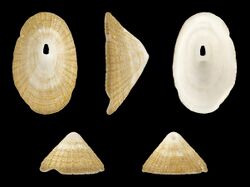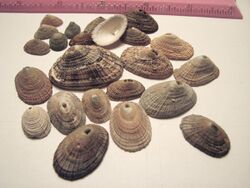Biology:Diodora cayenensis
| Diodora cayenensis | |
|---|---|

| |
| Scientific classification | |
| Domain: | Eukaryota |
| Kingdom: | Animalia |
| Phylum: | Mollusca |
| Class: | Gastropoda |
| Subclass: | Vetigastropoda |
| Order: | Lepetellida |
| Family: | Fissurellidae |
| Genus: | Diodora |
| Species: | D. cayenensis
|
| Binomial name | |
| Diodora cayenensis (Lamarck, 1822) [1]
| |
| Synonyms | |
| |
Diodora cayenensis, the Cayenne keyhole limpet, is a species of small to medium-sized sea snail or limpet, a western Atlantic marine prosobranch gastropod mollusk in the family Fissurellidae, the keyhole limpets.[2]
This species is named after Cayenne, the capital of French Guiana. The spelling using one "n" is original and is therefore retained.
Distribution
The Cayenne keyhole limpet is found from New Jersey south through the West Indies to Brazil; in the Gulf of Mexico and in the Caribbean Sea; off the Canary Islands.
Shell description
This shell of this species varies from 15 mm to 50 mm in size and is shaped like a low cone with a small, subcentral keyhole-like opening or orifice on the top of the shell. The shell has an external sculpture of many radiating ribs. Internally, the keyhole opening is outlined by a truncate callus, which has a deep pit on its posterior edge.
The external coloration of the shell varies from white to pinkish gray or brown sometimes with faint rays, and the interior of the shell is white to gray.
This species of limpet lives in inlets and offshore waters attached to rocks or shells and is occasionally found washed up on sound and ocean beaches.
Life habits
The Cayenne keyhole limpet is a herbivore, and uses its radula to scrape algae from rocks. Its powerful foot creates strong suction to keep waves from washing it off the rocks.
Water for respiration and excretion is drawn in under the edge of the shell and exits through the "keyhole" near the peak.
The eggs of this species are yellow and are stuck to rocks. The young hatch and crawl away.
Reproduction
The Cayenne keyhole limpet reproduces via broadcast spawning. Because intertidal zones are a constantly changing environment, D. cayenensis release large quantities of eggs into the water in order to increase fertilization rates (Monteiro 2012).
References
- ↑ Lamarck, [J. B.] 1822. Histoire naturelle des animaux sans vertèbres. Histoire Naturelle des Animaux sans Vertèbres 6(2): [iii] + 232 pp. Author: Paris
- ↑ Rosenberg, G. (2012). Diodora cayenensis (Lamarck, 1822). Accessed through: World Register of Marine Species at http://www.marinespecies.org/aphia.php?p=taxdetails&id=160265 on 2013-01-08
2. Monteiro, Serrão, E. A., & Pearson, G. A. (2012). Prezygotic barriers to hybridization in marine broadcast spawners: reproductive timing and mating system variation. PloS One, 7(4), e35978–e35978. https://doi.org/10.1371/journal.pone.0035978.
- Keyhole Limpet and NC Sea Grant
- Cayenne Keyhole Limpet
- Diodora cayenensis
- Say, T. 1822. An account of some of the marine shells of the United States. Journal of the Academy of Natural Sciences of Philadelphia 2: 221-248, 257-276, 302-325.
- Reeve, L. 1850. Monograph of the genus Fissurella. Conchologia Iconica 6: pls. 9-16
- Turgeon, D.D., et al. 1998. Common and scientific names of aquatic invertebrates of the United States and Canada. American Fisheries Society Special Publication 26 page(s): 58
- Rosenberg, G., F. Moretzsohn, and E. F. García. 2009. Gastropoda (Mollusca) of the Gulf of Mexico, Pp. 579–699 in Felder, D.L. and D.K. Camp (eds.), Gulf of Mexico–Origins, Waters, and Biota. Biodiversity. Texas A&M Press, College Station, Texas
- Intergovernmental Oceanographic Commission (IOC) of UNESCO. The Ocean Biogeographic Information System (OBIS)
Wikidata ☰ Q3174060 entry
 |


